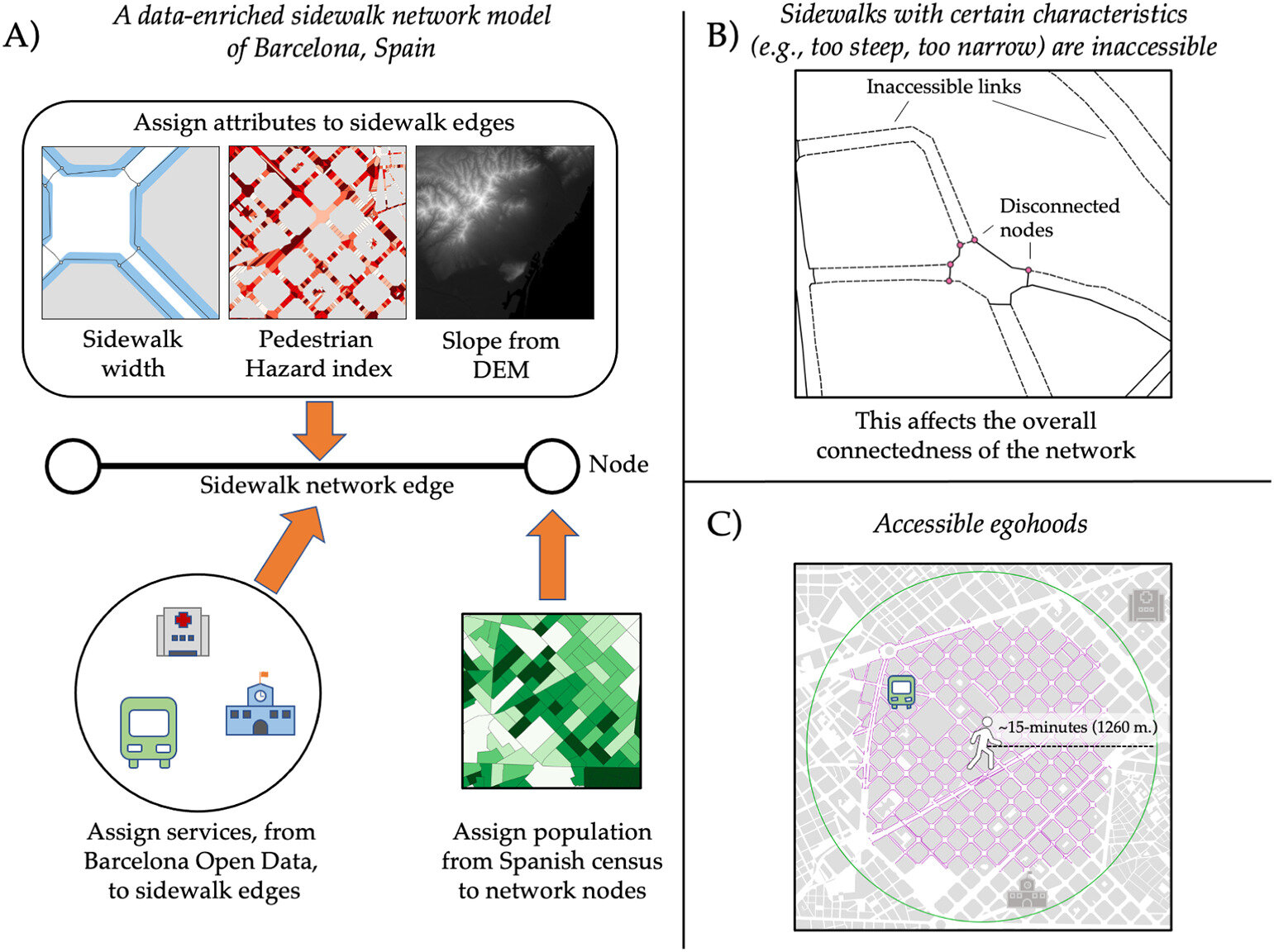Neither artificial intelligence nor the metaverse will define the cities of the future. Instead, everything points to it being something as matter of fact as proximity to services. This is what’s known as the 15-minute city, and work is already being carried out on it in cities like Barcelona, Paris, Bogotá, Shanghai and Melbourne.
In this new urban model, based on traveling by foot, one urban feature that is not always given the attention it deserves takes on particular importance: the sidewalk. This topic has been studied by three researchers from the Complex Systems (CoSIN3) group of the Internet Interdisciplinary Institute (IN3) at the Universitat Oberta de Catalunya (UOC): Daniel Rhoads, Albert Solé Ribalta and Javier Borge Holthoefer.
“We have developed a flexible framework to test the robustness of city sidewalk networks in relation to residents’ diverse mobility constraints and have applied it to Barcelona,” explained Rhoads. The result is that “even a pedestrian-friendly city like Barcelona does not hold up to the 15-minute city when moderate physical limitations are taken into account.”
“For the last 100 years, humankind has created cities designed for traveling by car. Now, they’re beginning to be adapted for moving around by foot,” said Rhoads. In the study, the results of which have been published as open access in the journal Computers, Environment and Urban Systems, the authors discuss different approaches to improving the sidewalk network. “We propose a framework for assessing multi-factor walkability using percolation theory and insights into pedestrian behavior,” explained Rhoads.
The authors worked on a digital depiction of Barcelona’s sidewalk system, with information such as sidewalk width, slope and risk level based on traffic accident data. The method employed allowed the researchers to see how network connectivity varies depending upon people’s mobility requirements.
“For instance, someone in a wheelchair requires at least two meters’ width and slopes that are not in excess of two degrees,” said Rhoads. “By focusing our analysis on any point in the city, we can ascertain how many key services can be accessed by someone within a 15-minute walk, under any combination of conditions.”
The 15-minute city
“This is a quite recent idea put forward by the urbanist Carlos Moreno, a Paris-based Colombian, in which cars are kept away from the city’s center,” said Rhoads. Broadly speaking, this new urban model seeks to ensure that all everyday needs can be met within a reasonable walk’s distance: going to a supermarket, to the doctor, to school, to a park, to the library or to a public transport stop.
“This means all these services must be distributed across the whole of a city’s territory but, first of all, there is a need to define what key services actually are and what the optimal locations to reach the greatest number of people are,” said Rhoads. “Rebuilding cities is not easy.”
“With its superblocks policy, Barcelona is making progress towards this model. At a global level, due to its reasonable size, its robust public transport system, and the distribution of the population throughout the urban area, which combines residential buildings and businesses, it can already be considered a fairly walkable city,” said Rhoads from the United States, where he lives. “Here, cities are much more horizontal, the distances are enormous, and everything is designed for cars.”
The ultimate goal of the 15-minute city is to improve the quality of life of its inhabitants. “Walking is a healthy way of exercising and, by reducing the number of trips made in vehicles powered by combustion engines, it improves air quality, cuts greenhouse gas emissions and reduces the risk of traffic accidents,” Rhoads pointed out.
More information:
Daniel Rhoads et al, The inclusive 15-minute city: Walkability analysis with sidewalk networks, Computers, Environment and Urban Systems (2023).
DOI: 10.1016/j.compenvurbsys.2022.101936
Provided by Universitat Oberta de Catalunya (UOC)
Citation:
The 15-minute city begins with sidewalks that aid mobility: Study proposes a new urban model (2023, May 10)
retrieved 10 May 2023
from https://phys.org/news/2023-05-minute-city-sidewalks-aid-mobility.html
This document is subject to copyright. Apart from any fair dealing for the purpose of private study or research, no
part may be reproduced without the written permission. The content is provided for information purposes only.
Denial of responsibility! TechCodex is an automatic aggregator of the all world’s media. In each content, the hyperlink to the primary source is specified. All trademarks belong to their rightful owners, and all materials to their authors. For any complaint, please reach us at – [email protected]. We will take necessory action within 24 hours.

Jessica Irvine is a tech enthusiast specializing in gadgets. From smart home devices to cutting-edge electronics, Jessica explores the world of consumer tech, offering readers comprehensive reviews, hands-on experiences, and expert insights into the coolest and most innovative gadgets on the market.


